Origin Materials (NASDAQ:ORGN) is a company with a goal to reduce carbon footprint by producing materials that are carbon-negative. The company has an interesting approach, patented technologies and processes and several large customers already lined up which promises future growth but at the same time it is burning cash at a dangerous rate and it will need additional funding in order to survive and prosper which makes it a highly speculative investment for most investors.
Using its patented platform technology, the company seeks to produce a large variety of products such as clothing, food packaging, car parts, tires, adhesives which are currently being produced using petroleum-based materials and plastic. In theory this could reduce our carbon footprint and hopefully make a reduction in greenhouse gas emissions which could help the environment. As noble as this goal is, as investors, we are more focused on whether this can be turned into profits for the company though.
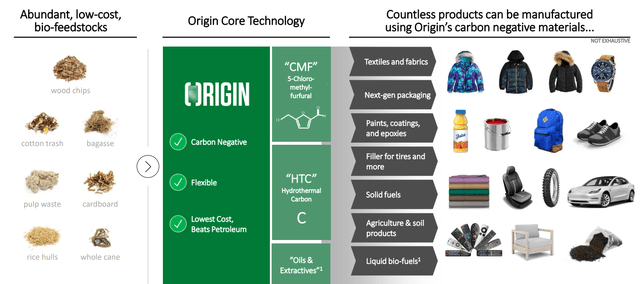
Origin Value Proposition (Origin)
The company’s technology platforms allow usage of renewable and organic materials such as harvested wood residues, agricultural waste, and wood waste to produce the same products that are currently being used with petroleum-based materials. In theory organic materials also contain carbon but it’s processed differently and it is very difficult to make materials using organic materials in an efficient way that would support mass production at affordable levels. This company argues that its patented technologies will make it possible to produce a variety of products in a carbon-negative way and its products will match those petroleum-based products in terms of quality, endurability and performance. Below is from the company’s latest annual report.
We believe that products made using Origin’s platform technology can compete directly with petroleum-derived products on both performance and price. Due to abundant and renewable wood supplies that have historically stable pricing, our cost of production is expected to be more stable than potential competing platforms that use other types of feedstocks. We believe that end products made using our platform technology will have a significant unit cost advantage over products made from other low carbon feedstocks.
At first, one could be skeptical of these claims but it looks like the company’s platform has other believers too as it has some well-known committed partners and customers including Ford (F), PepsiCo (PEP) and Nestle (OTCPK:NSRGY) who has shown at least some interest in testing its platform.
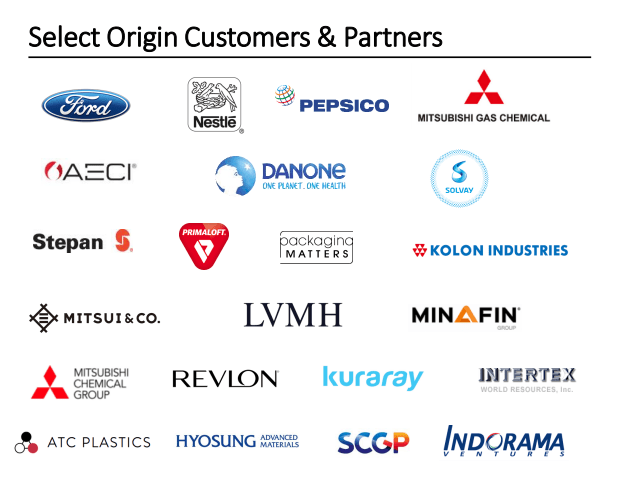
Select Customers and Partners (Origin Materials)
In its latest earnings report, the company said that it had received a cumulative demand that is north of $10 billion so far, $9 billion of which happened in the last couple years. This doesn’t necessarily mean that it has a $10 billion backlog or that it has a $10 billion worth of orders placed. This number mostly represents the amount of interest expressed in the company’s products that can be potentially turned into actual orders. The company sees its total eventual addressable market to be as large as $1 trillion which sounds impressive and appears to give the company tons of room for growth.

Cumulative Demand (Origin)
Here comes the challenging part though. In order to convert these potential orders (and future orders) the company has to make huge investments and create a whole infrastructure, new supply chains and production facilities, which is extremely costly. The company has very little cash and very few resources to scale up in any meaningful way and it will need a lot of capital to grow and it will likely post large losses for the foreseeable future.
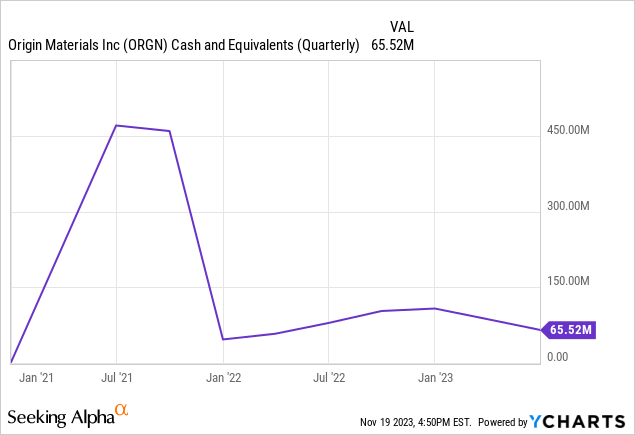
The company realized that it was trying to grow a little too aggressively considering its lack of resources to fund adequate growth. This is why when the company announced its results a couple weeks ago, it announced that it is scaling back on some of its initiatives. Some of the joint development programs that were expected to close this year will not close until next year. Also the company scaled back on its revenue projections from $40-60 million to $25-30 million, not because of lack of demand but because it needs to scale up its production which will be very costly. Interestingly enough, the company also said that its EBITDA loss will be slightly smaller than originally anticipated but it won’t be small either. The company now expects to lose $45-50 million this year, which may not look like a large number but it actually is considering its total market cap is $100 million and its total cash reserves total $65 million.
At the rate the company is bleeding cash (negative $59 million in operating cash flow and negative $190 million in free cash flow) it will certainly need more cash injections in order to fund its projected growth. This may pose a huge challenge to the company considering the current environment of high interest rates and shrinking liquidity.
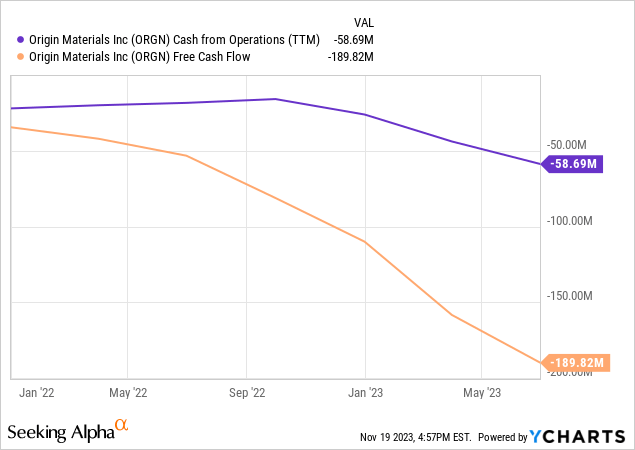
If the company can find the resources to survive this period and increase its scale, its long term prospects don’t look very bad. In the last 100 years, the amount of petroleum-based plastic usage increased by more than 10 fold and it is expected to double every 10 years. Plastic is not easily biodegradable and we are already finding traces of it in the air, oceans and everywhere else. There is even research showing traces of microplastics in human blood. The problem goes beyond carbon footprint and climate change and affects many aspects of our lives and it is important to find a sustainable solution where we can replace plastics in many products with biodegradable versions. If this company’s process proves scalable, it can open doors to huge opportunities. Not only would it save money in production costs but also healthcare costs associated with environmental pollution.
Analysts expect the company’s revenues to grow significantly from $38 million this year to $101 million next year, $240 million by 2027, $372 million by 2028 and $722 million by 2029. But the same analysts also expect the company to keep posting losses for the foreseeable time which means it may need multiple injections of cash for the next several years because it is very costly for the company to scale up its production to match the demand it says it will see in the future.
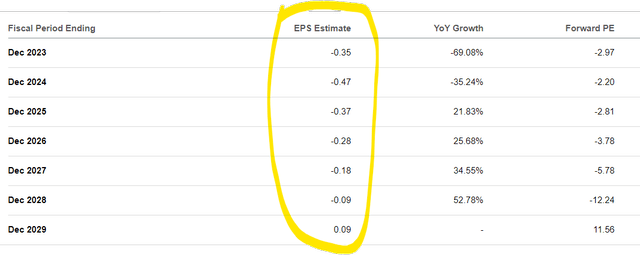
Analyst Estimates (Seeking Alpha)
Investors as a whole have lost a lot of faith in this company in the last couple years since it went public. The stock is now down almost 90% and the company’s market cap dropped from $1 billion to $100 million.
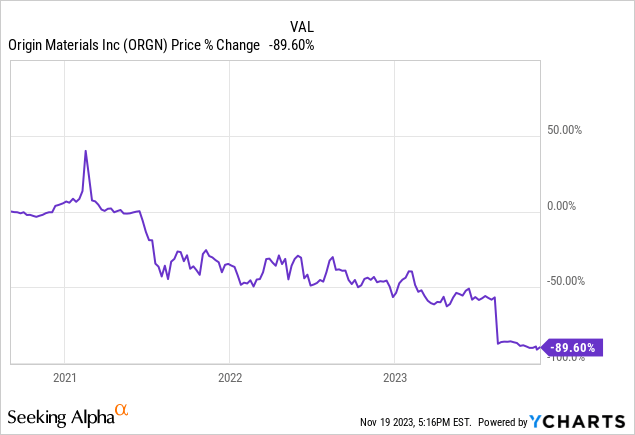
Earlier I mentioned that the company has several big name partners and customers like Ford and Nestle. It is possible that these companies could support Origin with early cash advancements or cash injections if they really believe in the company’s products so that it can scale up production but it’s too early to tell right now. The company could also become an acquisition target if its patents are found to be as valuable as its management says they are if the company is unable to post a profit or fund external funding to keep its lights on.
The company itself has much rosier projections as compared to projections of analysts and investors. It actually sees itself generating $4 billion in revenues and $2.3 billion in EBITDA income by 2030 with an EBITDA margin of 60%. This is significantly different from analyst estimates I shared above. I believe if the company had unlimited resources to scale up its production at will, it could probably grow at a tremendous rate but it will be very challenging for it to post these numbers without spending a tremendous amount of money on scaling up which it doesn’t readily have.
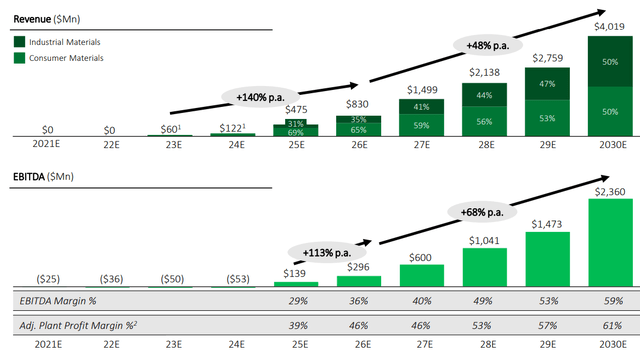
The company’s own projections (Origin)
Investors obviously don’t believe in the company’s long term projections. Otherwise they wouldn’t assign a market cap of $100 million for a company that projects that it will earn $139 million in 2025 giving it a forward P/E of 0.71 not to mention a forward P/E of 0.33 for 2026 estimated EBITDA and 0.16 for 2027. If investors believed in these numbers, stock wouldn’t be down -90% in the last couple years.
The company’s projections could become reality if it found sufficient funding, scaled up rapidly, kept its partnerships and customers in place and had strong cost-control measures over the years. There are multiple unknowns and moving parts in this story. Over the years the company has to build multiple plants, new supply chains, new infrastructure and new ways of producing things but it will need a lot of money to make these things happen and money is very costly right now. This is why this stock remains a speculative play that can either deliver 10x returns or go to zero in coming years and it’s very difficult to tell where it will go at the rate it’s burning cash.
Read the full article here










